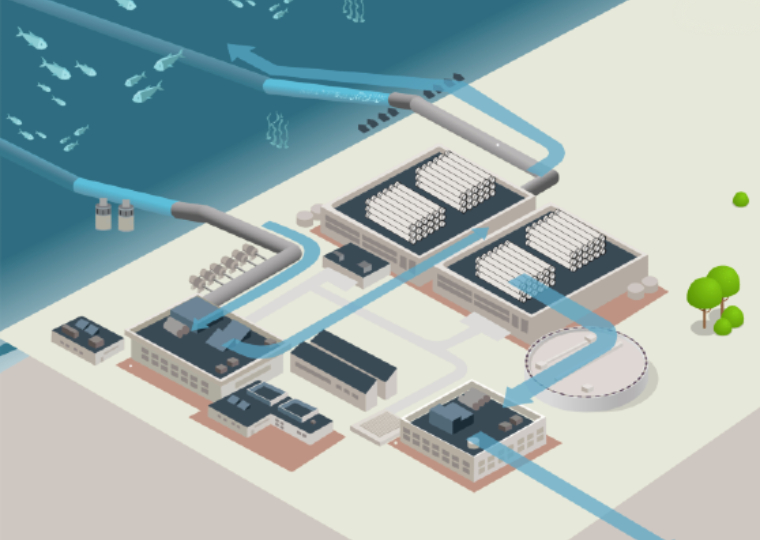-
Fixing the view on 98% of the salt water that makes up the Earth and using it to supply places with water escalation is possible. Discover the process of desalination by reverse osmosis.
-
The first settlers on the Canary Island of El Hierro (Spain), the Bimbache aborigines from Africa, survived in a land where, at least in appearance, hardly any water flowed. A terrain without rivers, without streams, without water sources… But it had a secret that had long guaranteed the survival of this people: the Garoé tree.
The Garoé tree was a huge lime tree with a luscious crown. Thanks to its location, its leaves collected water from the fog. This then fell into a pond where it was collected for human consumption or for livestock. The fact that Fray Bartolomé de las Casas discusses this in Historia de las Indias (History of the Indies) in 1524 makes us think that it is more than just a legend. To that people, the Garoé tree was a fountain of wealth and the key to its survival.
The story that follows tells of how, before their invasion by European troops, the Bimbaches decided to hide the tree in the hope that the newcomers would not find fresh water and would leave the island. But a young indigenous woman fell in love with one of the soldiers and, scared he would leave her, told him the secret of the Fountain Tree. That was the beginning of the end for the indigenous people. The mystery of water would seal its fate for better or worse.
Now is not the time to verify the story, but this moving legend serves to illustrate the role of water in the survival of civilisations and in the evolution of their history. Water as a source of life. A resource so vital to present and future generations, and sometimes so scarce, that it can even become a sacred resource.
-
Access to water, an unequal distribution
Access to water is one of humanity's greatest problems and one of the most worrying sources of conflict in many areas of the planet. Water resources are unevenly distributed and, although the UN has established access to water as one of the Fundamental Human Rights and made it the focus of Sustainable Development Goal 6 of the 2030 Agenda, water shortages affect 40% of the global population today.
The data is telling. Just six countries account for nearly 50% of the world's water resources: Brazil, the United States, Canada, Russia, India and China. And 27% of this water can be found in just five river systems: the Amazon, Congo, Ganges-Brahmaputra, Yellow River and Orinoco. Beyond this overabundance, there are many areas of the planet with alarming water stress where water is consumed at a faster rate than it can be replenished.
One of the most effective ways of dealing with this problem is to focus on the fact that 98% of Earth's water is saltwater and to take advantage of this water to supply the places that need it the most, once it has been turned into clean and ready-to-drink water. Desalination, especially desalination by reverse osmosis, makes this possible.
-
Desalination: a sustainable and efficient solution to water shortage
Converting seawater into drinking water is technologically possible. At ACCIONA we have been doing this for a long time in our reverse osmosis desalination plants, nowadays using the most advanced, efficient and environmentally friendly technology.
But what is reverse osmosis desalination? We explain this in more detail in infographic below. But, basically, it is a process in which pressure is applied to seawater containing salt, this water then passes through a membrane and we obtain clean water free from salt particles, which have been caught on the other side of the membrane. The clean water undergoes a remineralisation process and is sent to homes for consumption, while the resultant brine is diluted before being returned to the sea to avoid high concentrations of salt.
So far, reverse osmosis technology is not only the most economical solution, but also the most sustainable:
- A five-litre bottle in the supermarket costs the same as desalinating 1,000 litres of water.
- And desalinating 1,000 litres of water uses the same amount of energy as an air conditioning system in a house for one hour.
- Reverse osmosis also produces 6.5 times fewer CO₂ emissions than conventional desalination technology.
-

-
Drinking water for more than 25 million people
ACCIONA is a leading company in the process of reverse osmosis desalination. It is an experience encompassing the design, construction, commissioning, operation and maintenance of plants. Each of these tasks has the support of the R+D+i department with the aim of continuously boosting the efficiency of the processes.
A FEW FACTS ABOUT ACCIONA AND REVERSE OSMOSIS TECHNOLOGY
- More than 80 desalination plants built around the world
- A treatment capacity of about 4.6 million m3/day
- Capable of supplying water to more than 25 million people
- Operating in 34 countries.
Find out more about all of our desalination projects here.
Sources: University of Alcalá, Jot Down, Sustainability for all
-
-
How a large-scale photovoltaic plant is built in record time
Spectacular image gallery showing the step-by-step construction of a large-scale photovoltaic plant with more than a million solar panels in record time, and in the heart of the desert, no less.
-
-
-





